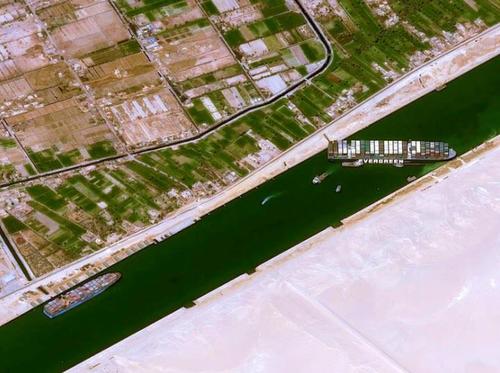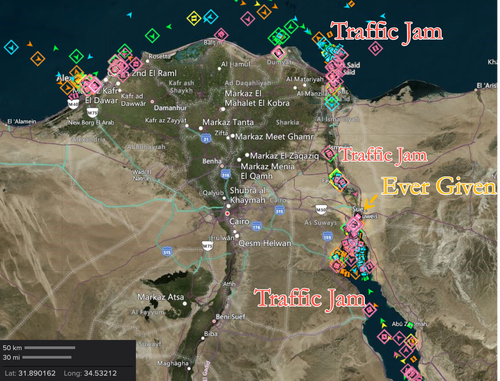Over 300 Ships Now Stranded As Suez Canal Authority Chairman Says "Human Error" Contributed To Crash
Update (1653ET): Egypt Today Magazine reports Ever Given has moved "17 meters towards the north, and there are positive indications that the ship would be refloated soon because of the high tide today." With rising sea levels tonight, Lieutenant-General Osama Rabie, Chairman of the Suez Canal Authority (SCA), said the containership might refloat.
Egypt Today Magazine says the best time to refloat the stranded containership could be sometime tonight "due to the highest tidewater and the wind today is strong and helps the ship move towards the northeast."
Rabie said the vessel moved 30 degrees in both directions on Saturday.
This is positive news, but the massive containership remains stuck in the canal as more than 300 ships are waiting to transit one of the world's most important shipping lanes.
More than 300 vessels are log-jammed at either end of the Suez Canal on Saturday, though an increasing number of vessels were being diverted to the southern tip of Africa, also known as the Cape of Good Hope.
Lieutenant-General Osama Rabie, Chairman of the Suez Canal Authority (SCA), said at least 14 tugboats and a dredging ship worked around the clock to free the stranded containership 'Ever Given'.
I’ve got boots on the ground reporting from the Suez Canal - Ever Given is an absolute unit pic.twitter.com/Qv1S4vC0UY
— litquidity (@litcapital) March 26, 2021
Rabie said 9,000 tons of ballast water were removed from the ship. Dredgers had removed some 20,000 tonnes of sand from around its bow by Friday, and the rudder and propeller system of the vessel was restarted.
He said the stern of the vessel started to move last before refloating efforts stopped.
“The bow is really stuck in the sandy clay, but the stern has not been pushed totally into the clay, which is positive. We can try to use that as leverage to pull it loose,” Peter Berdowski, chief executive of Boskalis, which owns Smit Salvage, which was brought in this week to help with efforts, said.
“Heavy tugboats, with a combined capacity of 400 tonnes, will arrive this weekend. We hope that a combination of the tugboats, dredging of sand at the bow and a high tide will enable us to get the ship loose at the beginning of next week.”
The chairman said around 321 ships were waiting to transit the canal as of Saturday.
Many of the vessels stuck in or around the Suez Canal are carrying billions of dollars of goods, such as crude, crude products, automobiles, electronics, livestock, other consumer goods, and other commodities.
Rabie also said wind speeds were not the main reason for stranding the ship on the side of the canal. He said technical or human error could have contributed to the incident. Mike Shedlock laid out a list of potential factors:
-
No Tugs: The Ever Given didn’t employ tug boats, according to two people with knowledge of the situation, while the two slightly smaller container ships immediately ahead did.
-
Poor Visibility: The Rasheeda was among the ships approaching the canal from the southern end. Mindful of the dangers of the coming sandstorm and laden with liquefied natural gas from Qatar, the captain decided not to enter the canal after discussion with other officials at Royal Dutch Shell Plc, which manages the ship
-
Speed: The ship’s last known speed was 13.5 knots at 7:28 a.m., 12 minutes before the grounding, according to Bloomberg data. That would have surpassed the speed limit of about 7.6 knots (8.7 miles an hour) to 8.6 knots that is listed as the maximum speed vessels are “allowed to transit” through the canal, according to the Suez authority’s rules of navigation handbook posted on its website. Captains interviewed for this story said it can pay to increase the speed in the face of a strong wind to maneuver the ship better.
-
Escorts Not Mandatory: The Cosco Galaxy, a container ship marginally smaller than the Ever Given, was immediately ahead and appears to have travelled at a similar speed, though with a tugboat. The one ahead of the Cosco, the Al Nasriyah, also had an escort. The escorts are not mandatory, according to the Suez authority’s rules of navigation, though the authority can require it for ships if they deem it necessary.
-
Cargo Load: A cargo ship with containers stacked high like the Ever Given can be particularly hard to navigate since the ship’s hull and wall of containers can act as a huge sail, said Kinsey, the former captain, who made his last trip through Suez in 2006 . “There’s a very fine line between having enough speed to maneuver and not having too much speed that the air and hydrodynamics become unstable. Any deviation can get real bad real quick because it’s so tight,” said Kinsey.
And the worst-case scenario might play out if the ongoing dredging to refloat the ship assisted with tugboats and high tide doesn't work, that is, as explained by the chairman, the possibility of lightening the vessel's load. He hoped the salvage team wouldn't have to come to that because, as JPMorgan's Marko Kolanovic told clients Friday, unloading the ship could result in a "ship breaking."
As Kolanovic puts it, "another interesting development of this week was the blocking of the Suez Canal. While we believe and hope the situation will get resolved shortly, there are some risks of the ship breaking."
Additionally, Reuters reports that Boskalis and Smit Salvage have warned that using too much force to tug the ship could damage it. Berdowski said a land crane would be brought in at the weekend which could lighten the Ever Given’s load by removing containers, though experts have warned that such a process could be complex and lengthy.
“If we don’t succeed in getting it loose next week, we will have to remove some 600 containers from the bow to reduce the weight,” he said.
“That will set us back days at least, because where to leave all those containers will be quite a puzzle."
Rabie did not give any timelines on when the vessel would be refloated. He said the stranded ship would need to be surveyed after it was refloated.
There's still no word on the US Navy's assessment of the vessel.
As a reminder, this is not the first accident for the 'Ever Given':
Wikipedia notes: On 9 February 2019, the ship struck and heavily damaged a 25-meter-long HADAG ferry boat at Blankenese, near the harbour of Hamburg. Two minutes after the collision, a traffic ban on the Elbe river was issued due to high winds.
The blockage of the world's most crucial shipping lane has added significant pressure to the already stretched global supply chain.
Disclaimer: Copyright ©2009-2021 ZeroHedge.com/ABC Media, LTD; All Rights Reserved. Zero Hedge is intended for Mature Audiences. Familiarize yourself with our legal and use policies every time ...
more





